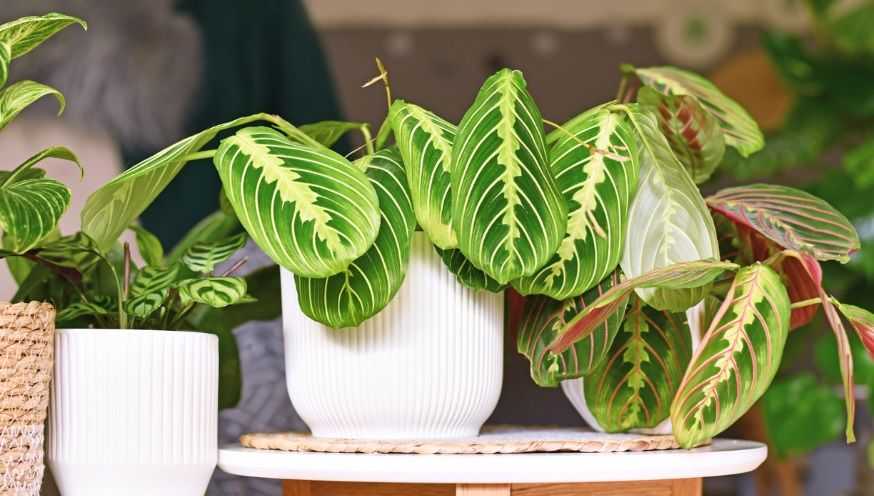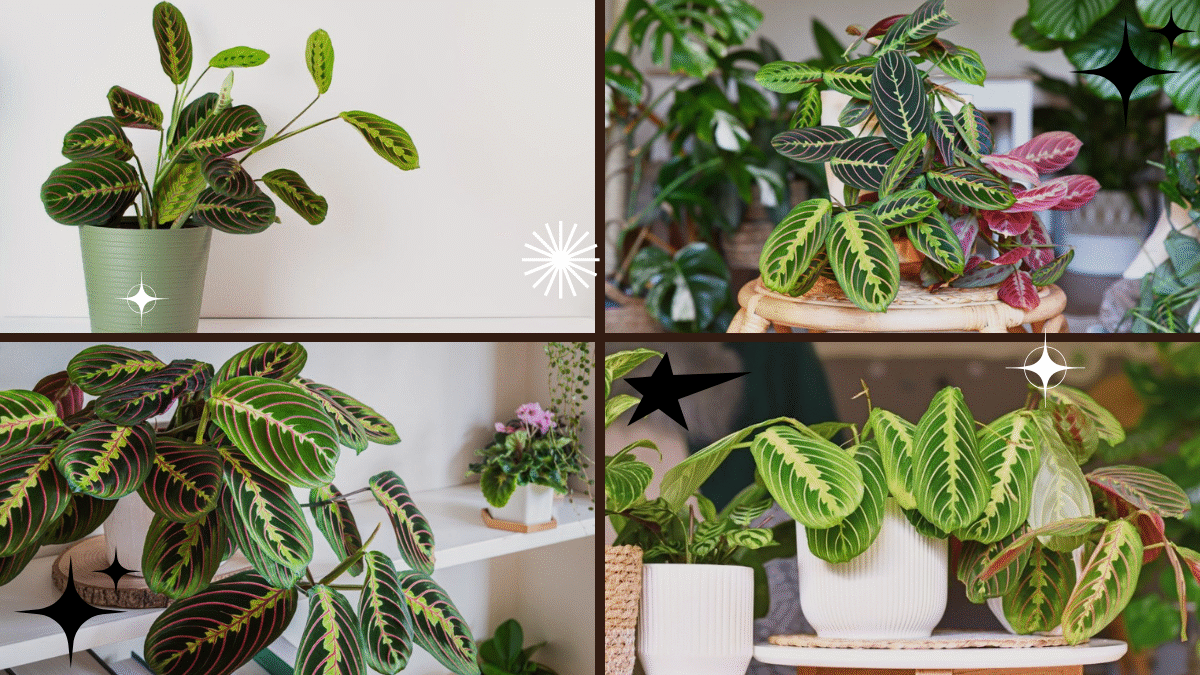Indoor houseplants have a unique way of bringing life, beauty, and tranquility into your living space. Among the most enchanting of them is the Prayer Plant. Known for its striking, patterned leaves and fascinating behavior of folding its leaves at night — as if in prayer — this plant has charmed plant enthusiasts around the world.
If you’re thinking about adding one of these beauties to your collection, or you already have one and want to learn how to help it thrive, this detailed care guide will walk you through everything you need to know about how to care for a Prayer Plant indoors.

What Is a Prayer Plant?
The Prayer Plant (scientific name Maranta leuconeura) is native to the tropical rainforests of Brazil. It belongs to the Marantaceae family, known for its eye-catching foliage. The plant’s name comes from its remarkable behavior: at dusk, its leaves lift upward as if in a praying posture, and then lower again in the morning.
Prayer Plants are cherished for their:
- Bold leaf patterns: Featuring shades of green, red, and cream with vein-like designs.
- Unique movement: Leaves fold up at night and unfold during the day.
- Compact size: Making them ideal for small spaces, shelves, and tabletops.
Popular varieties include:
- Maranta leuconeura ‘Erythroneura’ (Red Prayer Plant) with dark green leaves and red veins.
- Maranta leuconeura ‘Kerchoveana’ (Green Prayer Plant) with green leaves spotted with darker green patches.

Benefits of Growing a Prayer Plant Indoors
Besides being visually stunning, Prayer Plants offer several indoor benefits:
- Air purification: Helps remove common indoor toxins.
- Compact growth habit: Perfect for apartments, offices, or smaller homes.
- Conversation starter: Its leaf movements captivate guests and plant lovers alike.
- Pet-friendly: Non-toxic to cats and dogs.

How to Care for a Prayer Plant Indoors
While Prayer Plants are considered moderately easy to care for, they do have a few specific preferences you’ll need to meet to help them flourish.
1. Lighting Requirements
Prayer Plants prefer bright, indirect light. They thrive in areas with filtered sunlight but can tolerate lower light conditions better than some other tropical plants.
- Ideal light: A north- or east-facing window where it gets plenty of indirect light.
- Too much direct sun: Can scorch the leaves, causing browning and faded patterns.
- Low light: Will slow growth and may reduce leaf color vibrancy.
Tip: If you notice the leaves fading or curling, try moving your plant to a brighter, indirect light spot.
2. Watering Schedule
Prayer Plants love consistent moisture but dislike soggy soil. Getting the watering routine right is crucial:
- Water when the top inch of soil feels dry.
- Use room-temperature, filtered, or rainwater if possible, as they can be sensitive to fluoride and chlorine.
- Water thoroughly until excess drains out, but always empty the saucer to avoid root rot.
- In winter: Reduce watering frequency as growth naturally slows.
Signs of overwatering: Yellowing leaves, mushy stems, or black root tips.
Signs of underwatering: Crisp, brown leaf edges and wilting leaves.
3. Temperature and Humidity Needs
Since Prayer Plants originate from tropical rainforests, they prefer warm and humid conditions.
- Ideal temperature: Between 65°F to 80°F (18°C to 27°C). Avoid placing it near cold drafts, air conditioners, or heaters.
- Humidity: High humidity levels are key. Aim for 50% or higher.
How to increase humidity:
- Mist leaves regularly with water.
- Place the plant on a pebble tray with water.
- Use a humidifier nearby.
- Group plants together to naturally raise humidity.
4. Best Soil and Potting
Prayer Plants thrive in well-draining, slightly acidic soil that retains some moisture but doesn’t stay soggy.
- Soil mix suggestion: Combine potting soil with perlite, orchid bark, and a bit of peat moss or coco coir for moisture retention and good drainage.
- Pot selection: Use a pot with drainage holes to avoid water accumulation at the roots.
Repot every 2–3 years or when the roots outgrow the container.
5. Fertilizing for Healthy Growth
Like most houseplants, Prayer Plants benefit from regular feeding during their growing season.
- When to feed: Every 4 weeks from spring through early fall.
- Fertilizer type: Use a balanced, water-soluble houseplant fertilizer diluted to half strength.
- Avoid over-fertilizing: Excess fertilizer can burn the roots and leaves.
Tip: Skip fertilizing in winter as the plant’s growth naturally slows.
6. Pruning and Maintenance
Regular pruning encourages bushier, fuller growth and keeps your plant looking tidy.
- When to prune: Anytime you notice leggy stems or damaged leaves.
- How to prune: Use clean, sharp scissors to trim just above a leaf node.
- Remove yellow, brown, or dead leaves promptly.
Bonus tip: You can propagate the healthy cuttings in water to grow new plants!
7. Propagation Tips
Propagation is a fun way to multiply your Prayer Plants and share them with friends.
Steps for water propagation:
- Cut a healthy stem just below a node (where the leaf and stem join).
- Remove the lower leaves, leaving a couple at the top.
- Place the cutting in a jar of filtered water, ensuring the node is submerged.
- Keep in a warm, bright spot, changing water every few days.
- Once roots are a couple of inches long, plant it in soil.
Soil propagation: You can also plant cuttings directly into moist soil, covering the node, and keep humidity high until roots establish.
8. Common Prayer Plant Problems and Solutions
| Problem | Cause | Solution |
|---|---|---|
| Brown leaf tips | Low humidity, underwatering | Increase humidity, check watering schedule |
| Yellowing leaves | Overwatering | Allow soil to dry slightly between watering |
| Faded or curling leaves | Too much direct sunlight | Move to a bright, indirect light spot |
| Spider mites or mealybugs | Dry air and poor airflow | Wipe leaves with insecticidal soap or neem oil |

Styling Ideas for Your Prayer Plant
Prayer Plants aren’t just pretty — they’re also incredibly versatile when it comes to indoor decor.
- Hanging planters: Let their leaves drape down for a cascading effect.
- Tabletop display: Their bold patterns make them perfect for accent tables or desks.
- Bathroom greenery: With higher humidity, bathrooms can be a great spot.
- Shelf display: Add them to plant shelves or mix with other tropical plants for a lush look.
Final Thoughts
Caring for a Prayer Plant indoors is a deeply rewarding experience. With its vibrant leaves, captivating nighttime movements, and relatively easy care needs, it’s the perfect choice for both novice and seasoned plant enthusiasts.
By offering the right balance of light, moisture, warmth, and humidity — along with occasional pruning and feeding — you’ll be rewarded with a thriving, beautiful plant that not only enhances your space but also connects you to nature’s gentle rhythms.
Ready to bring home a Prayer Plant? With a little love and attention, you’ll quickly see why this tropical gem remains a favorite in indoor gardens everywhere.





Leave A Comment